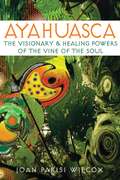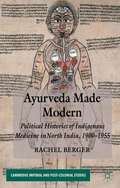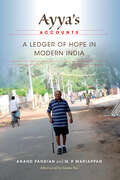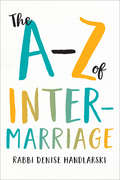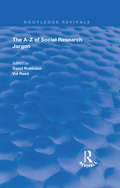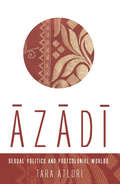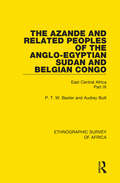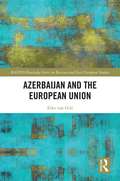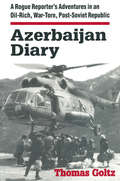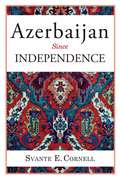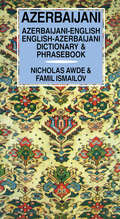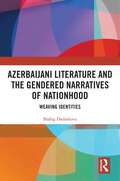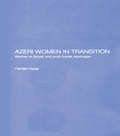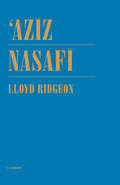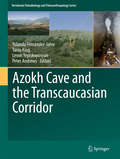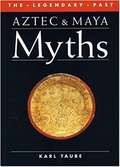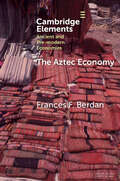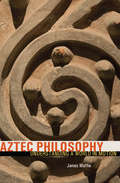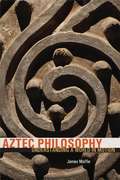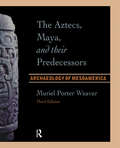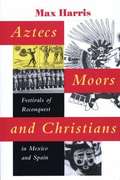- Table View
- List View
Ayahuasca: The Visionary and Healing Powers of the Vine of the Soul
by Joan Parisi WilcoxA comprehensive autobiographical account of the transforming experiences possible with ayahuasca• Reveals the protocols of a traditional ayahuasca retreat and the importance of its ritual diet, isolation, and sacred songs• Relates an extensive personal account of the traditional indigenous use of ayahuasca for healing and revelationAyahuasca: The Visionary and Healing Powers of the Vine of the Soul is an autobiographical account of the author’s work with ayahuasca, a potent and sacred plant brew of the Amazon region that is known for its extraordinary visionary and healing powers. As she learned from her experience, with the help of ayahuasca we are able to grasp our paradoxical nature, the first step to acceptance of ourselves in both our glorious and dark aspects. Ayahuasca teaches us how to release the illusions we hold about ourselves and makes it possible to integrate our many diverse aspects to acquire our true power. This book reveals the ritual protocols that must be followed prior to partaking of ayahuasca, including the traditional preparatory “diet”--which requires enduring austere conditions, isolation, and only small amounts of bland food before receiving the powers of the plant spirit from an ayahuasquero, a healing master--and the sacred songs, icaros, that are sung when imbibing the substance. Although the use of ayahuasca is growing among “underground” spiritual seekers and through the burgeoning ayahuasca tourism trade in South America, few of its seekers understand how it is used traditionally and the importance of the rituals the indigenous people follow. With this book, the author hopes to restore the importance of these indigenous practices so that we may truly understand all the gifts of ayahuasca.
Ayodhya: Archaeology After Demolition (Revised edition)
by D. MandalIt has been claimed that archaeological evidence provides irrefutable proof of the existence of a temple at the site of Ayodhya, and of the destruction of this temple by Babur.
Ayurveda Made Modern
by Rachel BergerThis book explores the ways in which Ayurveda, the oldest medical tradition of the Indian subcontinent, was transformed from a composite of 'ancient' medical knowledge into a 'modern' medical system, suited to the demands posed by apparatuses of health developed in late colonial India.
Ayya's Accounts: A Ledger of Hope in Modern India
by Anand Pandian M. P. Mariappan“An absorbing exploration of one man’s life” —as an orphan, refugee, shopkeeper, and grandfather—through a century of upheaval in India (Library Journal).Born in colonial India into a despised caste of former tree climbers, Ayya lost his mother as a child and came of age in a small town in lowland Burma. Forced to flee at the outbreak of World War II, he made a treacherous 1,700-mile journey by foot, boat, bullock cart, and rail back to southern India.Becoming a successful fruit merchant, Ayya educated and eventually settled many of his descendants in the United States. Luck, nerve, subterfuge, and sorrow all have their place along the precarious route of his advancement. Emerging out of tales told to his American grandson, Ayya’s Accounts embodies a simple faith—that the story of a place as large and complex as modern India can be told through the life of a single individual.“At once a mesmerizing memoir of an ordinary man’s life and an anthropologist’s revealing examination of the astounding changes experienced by persons and families . . . impossible to put down.” —South Asia“No one deemed a superhero by the movies has had a more interesting life with such extraordinary sweep.” —Scott Simon, NPR Weekend Edition
The A–Z of Intermarriage
by Denise HandlarskiMost Jewish communities continue to cite intermarriage as the most serious threat to Jewish continuity. Contrary to the view that intermarriage is a crisis for Judaism, The A–Z of Intermarriage reveals that intermarriage can be a force for good in the lives of Jewish families and communities. Written by Rabbi Denise Handlarski, an intermarried rabbi, The A–Z of Intermarriage is part story, part strategy, and all heart, as well as a coming together of religious source material, cultural context, and personal narrative. Fun to read and full of helpful and practical tips and tools for couples and families, this book is the perfect "how-to" manual for living a happy and balanced intermarried life. This book is for people who:- Are intermarried, open to intermarriage, or considering intermarriage- Have family members or friends who are intermarried or entering into an interfaith/intercultural relationship- Are seeking models, guidance, and tips about creating a happy relationship and family- Are interested in points of view about intermarriage and/or Judaism they have never heard or considered- Love "how-to" books- Want to know more about Jewish approaches to life, learning, and love
The A–Z of Social Research Jargon (Routledge Revivals)
by David Robinson Val ReedFirst published in 1998, this volume examines a major function of research which is to strengthen the knowledge base of health professions and so enhance patient care. The rapid growth has unfortunately led to it being seen by many as an elitist activity full of jargon, carried out by academics. This to some degree has led to a theory practice gap with some professionals not recognising their important role within the research process. It is important to dispel the myth that all practitioner should carry out research, though they should use elements of the research process to develop a questioning and evaluative approach to care. This book will enable reader to demystify and enhance their understanding of terminology used in research and contains almost 300 terms. It offers readers a unique approach to explanations for each term by offering its Everyday use; its Research use; an Example and Related terms.
Azadi: Sexual Politics and Postcolonial Worlds
by Tara AtluriIn December of 2012 in Delhi, India a woman was gang raped, tortured, and inflicted with such bodily violence that she died as a result of the injuries. The case caused massive public protests in Delhi and throughout the Indian subcontinent. These large scale public mobilizations lead to attempts to change national laws pertaining to sexual violence. One year after this case, The Supreme Court of India made the contentious decision to uphold Section 377 of the Indian Penal Code. Section 377, instituted by British colonizers dates back to 1860 and criminalizes sexual activities deemed to be "unnatural," namely queer sex and queer people. In December of 2013, massive protests also occurred throughout India regarding this decision. Both these cases received worldwide media attention and lead to public demonstrations and debates regarding sexual politics throughout Asia and globally. There was a resilient refrain heard at many of the political protests that took place: A¯za¯di¯. A¯za¯di is loosely translated into freedom. Drawing on interviews done in the Indian subcontinent, this book suggests that while colonial violence haunts postcolonial sexualities, anti-colonial resistance also remains, echoing in the streets like the chorus of an old song ~ A¯za¯di¯
The Azande and Related Peoples of the Anglo-Egyptian Sudan and Belgian Congo: East Central Africa Part IX
by Audrey Butt P. T. BaxterRoutledge is proud to be re-issuing this landmark series in association with the International African Institute. The series, originally published between 1950 and 1977, collected ethnographic information on the peoples of Africa, using all available sources: archives, memoirs and reports as well as anthropological research which, in 1945, had only just begun. Concise, critical and (for its time) accurate, the Ethnographic Survey contains sections as follows: Physical Environment Linguistic Data Demography History & Traditions of Origin Nomenclature Grouping Cultural Features: Religion, Witchcraft, Birth, Initiation, Burial Social & Political Organization: Kinship, Marriage, Inheritance, Slavery, Land Tenure, Warfare & Justice Economy & Trade Domestic Architecture Each of the 50 volumes will be available to buy individually, and these are organized into regional sub-groups: East Central Africa, North-Eastern Africa, Southern Africa, West Central Africa, Western Africa, and Central Africa Belgian Congo. The volumes are supplemented with maps, available to view on routledge.com or available as a pdf from the publishers.
Azerbaijan and the European Union (BASEES/Routledge Series on Russian and East European Studies)
by Eske van GilsThis book provides a comprehensive and up-to-date overview of EU-Azerbaijan relations. It examines the current state of Azerbaijan and its regime, charts the development of EU-Azerbaijan relations over time and discusses the dynamics at work in the relationship. It details the nature of the Azerbaijani regime, including its authoritarian character and allegations of corruption, explores the differences between European values and the values of the Azerbaijani government, and explains the difficulties that have arisen in the relationship, including the Nagorno-Karabakh conflict resolution process, media suppression and human rights violations. The book includes a comparison with EU relations with other states in the region.
Azerbaijan Diary: A Rogue Reporter's Adventures in an Oil-rich, War-torn, Post-Soviet Republic
by Thomas GoltzIn its first years as an independent state, Azerbaijan was a prime example of post-Soviet chaos - beset by coups and civil strife and astride an ethnic, political and religious divide. Author Goltz was detoured in Baku in mid-1991 and decided to stay, this diary is the record of his experiences.
Azerbaijan Since Independence (Studies of Central Asia and the Caucasus)
by Svante E. CornellAzerbaijan, a small post-Soviet republic located on the western shore of the Caspian Sea, has outsized importance becaus of its strategic location at the corssroads of Europe and Asia, its oil resources, and
Azerbaijani Dictionary and Phrasebook (Hippocrene Dictionary And Phrasebook Ser.)
by Nicholas Awde Famil IsmailovThis dictionary and phrasebook includes a dictionary of over 4,000 entries, plus an introduction to basic grammar and helpful phrasebook chapters covering subjects such as etiquette, the office, government, and food and drink. It is written entirely in the Roman alphabet.This unique language guides for getting around and communicating easily in everyday situations will be equally useful for tourists, business people and aid workers.
Azerbaijani Literature and the Gendered Narratives of Nationhood: Weaving Identities
by null Shafag DadashovaAzerbaijani Literature and the Gendered Narratives of Nationhood explores the dynamic relationship between Azerbaijani literature and the region's socio-political history. It examines how literature reflects and shapes national identity, with a focus on the gendered dimensions of this process.Analyzing literary works across different historical periods, this book reveals evolving gender roles and their portrayal in literature, highlighting the complex interaction between gender, literature, and the narratives that define gender identity. It offers a deep exploration of how women’s identities have been shaped, represented, and transformed in Azerbaijani literature from the 12th century to the post-Soviet era. Drawing on key gender theories, including the works of Judith Butler and Candace West, it examines how patriarchal structures have both restricted and enabled women’s agency across different historical periods. Through this, the volume traces the tension between tradition and modernity, highlighting how authors, as representatives of their times, perceived these tensions, interpreted them, and how they viewed the negotiation of gender roles, cultural norms, and national identity.Azerbaijani Literature and the Gendered Narratives of Nationhood is a valuable text for both students and scholars researching the history, literature and politics of Eastern Europe and Central Asia.
Azeri Women in Transition: Women in Soviet and Post-Soviet Azerbaijan (Central Asia Research Forum)
by Dr Farideh NfaThis study of women and gender in a Muslim society draws on archival and literary sources as well as the life stories of women of different generations to offer a unique ethnographic and historical account of the lives of urban women in contemporary Azerbaijan. Focussing on a group of professional women in Baku, it provides insight into the impact of the Soviet system on the position of Azeri women, their conceptions of femininity and the significant changes brought about by the post-Soviet transition to a market economy and growing western influence. Also explored are the ways in which local cultural expectations and Islamic beliefs were accommodated to different modernisation projects.
Aziz Nasafi
by Lloyd RidgeonShows Nasafi and his legacy in a new light. Nasafi's works are of particular interest because they contain valuable descriptions of the different Islamic world views of the age. Includes substantial extracts to help illuminate this perceptive study of a neglected figure in the pantheon of Sufi thinkers.
Azokh Cave and the Transcaucasian Corridor (Vertebrate Paleobiology and Paleoanthropology #0)
by Peter Andrews Yolanda Fernández-Jalvo Tania King Levon YepiskoposyanThis edited volume describes the geology, stratigraphy, anthropology, archaeology, dating, taphonomy, paleobotany, paleontology and paleoecology of Azokh caves (also known as Azykh or Azikh). The chapters review exhaustively the key recent research on this limestone karstic site, which is located near the village of the same name in the region of Nagorno Karabagh in the south-eastern end of the Lesser Caucasus. The site is significant due to its geographic location at an important migratory crossroad between Africa and Eurasia. These caves contain an almost complete sedimentary sequence of the transition between H. heidelbergensis and H. neanderthalensis continuing to later Pleistocene and Holocene stratified sediment. The site is also important due to the discovery of Neanderthal remains by the current research group in addition to the Middle Pleistocene hominin fossils during a previous phase of excavation work led by M. Huseinov. At the heart of this book is the matter of how this site relates to human evolution.
Aztec and Maya Myths (Legendary Past)
by Karl TaubeThe myths of the Aztec and Maya derive from a shared Mesoamerican cultural tradition. This is very much a living tradition, and many of the motifs and gods mentioned in early sources are still evoked in the lore of contemporary Mexico and Guatemala. <P><P> Professor Taube discusses the different sources for Aztec and Maya myths. The Aztec empire began less than 200 years before the Spanish conquest, and our knowledge of their mythology derives primarily from native colonial documents and manuscripts commissioned by the Spanish. The Maya mythology is far older, and our knowledge of it comes mainly from native manuscripts of the Classic period, over 600 years before the Spanish conquest. <P><P> Drawing on these sources as well as nineteenth- and twentieth-century excavations and research, including the interpretation of the codices and the decipherment of Maya hieroglyphic writing, the author discusses, among other things, the Popol Vuh myths of the Maya, the flood myth of Northern Yucatan, and the Aztec creation myths.
Aztec Archaeology and Ethnohistory
by Frances F. BerdanThis book provides an up-to-date synthesis of Aztec culture, applying interdisciplinary approaches (archaeology, ethnohistory and ethnography) to reconstructing the complex and enigmatic civilization. Frances F. Berdan offers a balanced assessment of complementary and sometimes contradictory sources in unravelling the ancient way of life. The book provides a cohesive view of the Aztecs and their empire, emphasizing the diversity and complexity of social, economic, political and religious roles played by the many kinds of people we call 'Aztecs'. Concluding with three integrative case studies, the book examines the stresses, dynamics and anchors of Aztec culture and society.
The Aztec Economic World
by Kenneth G. HirthThis study explores the organization, scale, complexity, and integration of Aztec commerce across Mesoamerica at Spanish contact. The aims of the book are threefold. The first is to construct an in-depth understanding of the economic organization of precolumbian Aztec society and how it developed in the way that it did. The second is to explore the livelihoods of the individuals who bought, sold, and moved goods across a cultural landscape that lacked both navigable rivers and animal transport. Finally, this study models Aztec economy in a way that facilitates its comparison to other ancient and premodern societies around the world. What makes the Aztec economy unique is that it developed one of the most sophisticated market economies in the ancient world in a society with one of the worse transportation systems. This is the first book to provide an updated and comprehensive view of the Aztec economy in thirty years.
The Aztec Economy (Elements in Ancient and Pre-modern Economies)
by Frances F. BerdanThe Aztec Economy provides a synthesis and updated examination of the Aztec economy (1325–1521 AD). It is organized around seven components that recur with other Elements in this series: historic and geographic background, domestic economy, institutional economy, specialization, forms of distribution and commercialization, economic development, and future directions. The Aztec world was complex, hierarchical, and multifaceted, and was in a constant state of demographic growth, recoveries from natural disasters, political alignments and realignments, and aggressive military engagements. The economy was likewise complex and dynamic, and characterized by intensive agriculture, exploitation of non-agricultural resources, utilitarian and luxury manufacturing, wide-scale specialization, merchants, markets, commodity monies, and tribute systems.
The Aztec Myths: A Guide To The Ancient Stories And Legends (Myths #0)
by Camilla TownsendThe essential guide to the world of Aztec mythology, based on Nahuatl-language sources that challenge the colonial history passed down to us by the Spanish. From their remote origins as migrating tribes to their rise as builders of empire, the Aztecs were among the most dynamic and feared peoples of ancient Mexico, with a belief system that was one of the most complex and vital in the ancient world. Historian Camilla Townsend returns to the original tales, told at the fireside by generations of Indigenous Nahuatl speakers. Along the way, she deals with human sacrifice, the raising of great temples, and the troubling legacy of the Spanish conquest. Few cultures are generally understood to have been so controlled by their religion as the Aztecs, and few religions are envisioned as being as violent and celebratory of death as theirs. In this introduction to the Aztec myths, Townsend draws from sixteenth-century historical annals and songs written down by Nahuatl-speaking peoples, now known as the Aztecs, in their own language to counter this narrative, inherited from the conquering Spaniards. In doing so, she reveals a rich tapestry of mythic tradition that defies modern expectations. Townsend retells stories ranging from the creation of the world, revealing the Aztec cosmological vision of nature and the divine, to legends of the Aztecs’ own past that show how they understood the foundation of their state and the course of their wars. She considers the impact of colonial contact on the myths and demonstrates that Indigenous engagement with the new cultural customs introduced by the Europeans never entirely uprooted old ways of thinking.
Aztec Philosophy: Understanding a World in Motion
by James MaffieIn Aztec Philosophy, James Maffie shows the Aztecs advanced a highly sophisticated and internally coherent systematic philosophy worthy of consideration alongside other philosophies from around the world. Bringing together the fields of comparative world philosophy and Mesoamerican studies, Maffie excavates the distinctly philosophical aspects of Aztec thought. Aztec Philosophy focuses on the ways Aztec metaphysics—the Aztecs’ understanding of the nature, structure and constitution of reality—underpinned Aztec thinking about wisdom, ethics, politics,\ and aesthetics, and served as a backdrop for Aztec religious practices as well as everyday activities such as weaving, farming, and warfare. Aztec metaphysicians conceived reality and cosmos as a grand, ongoing process of weaving—theirs was a world in motion. Drawing upon linguistic, ethnohistorical, archaeological, historical, and contemporary ethnographic evidence, Maffie argues that Aztec metaphysics maintained a processive, transformational, and non-hierarchical view of reality, time, and existence along with a pantheistic theology. Aztec Philosophy will be of great interest to Mesoamericanists, philosophers, religionists, folklorists, and Latin Americanists as well as students of indigenous philosophy, religion, and art of the Americas.
Aztec Philosophy
by James MaffieIn Aztec Philosophy, James Maffie reveals a highly sophisticated and systematic Aztec philosophy worthy of consideration alongside European philosophies of their time. Bringing together the fields of comparative world philosophy and Mesoamerican studies, Maffie excavates the distinctly philosophical aspects of Aztec thought.Aztec Philosophy focuses on the ways Aztec metaphysics--the Aztecs' understanding of the nature, structure and constitution of reality--underpinned Aztec thinking about wisdom, ethics, politics, and aesthetics, and served as a backdrop for Aztec religious practices as well as everyday activities such as weaving, farming, and warfare. Aztec metaphysicians conceived reality and cosmos as a grand, ongoing process of weaving--theirs was a world in motion. Drawing upon linguistic, ethnohistorical, archaeological, historical, and contemporary ethnographic evidence, Maffie argues that Aztec metaphysics maintained a processive, transformational, and non-hierarchical view of reality, time, and existence along with a pantheistic theology. Aztec Philosophy will be of great interest to Mesoamericanists, philosophers, religionists, folklorists, and Latin Americanists as well as students of indigenous philosophy, religion, and art in the Americas.
The Aztecs, Maya, and their Predecessors: Archaeology of Mesoamerica, Third Edition
by Muriel Porter WeaverThe Third Edition of this highly successful introduction to the archaeology of Mesoamerica includes full coverage of the Aztec and Maya areas in one volume. Beginning with the settling of the New World and continuing through the Spanish conquest of Mesoamerica in 1521, this completely updated textbook includes the deciphering of Maya hieroglyphs, the dynamic history of the Maya, the new royal tomb excavated at Copan, Honduras, important new discoveries at Rio Azul and Naj Tunich in Guatemala, and Caracol in Belize, ritual sacrifices on a massive scale revealed at Teotihuacan in central Mexico, and new material from Tula (Toltec capitol) and from the heart of Mexico City.
Aztecs, Moors, and Christians: Festivals of Reconquest in Mexico and Spain
by Max HarrisIn this insightful book, Max Harris seeks to understand Mexicans' "puzzling and enduring passion" for festivals of moros y cristianos. He begins by tracing the performances' roots in medieval Spain and showing how they came to be superimposed on the mock battles that had been a part of pre-contact Aztec calendar rituals. Then using James Scott's distinction between "public" and "hidden transcripts," he reveals how, in the hands of folk and indigenous performers, these spectacles of conquest became prophecies of the eventual reconquest of Mexico by the defeated Aztec peoples. Even today, as lively descriptions of current festivals make plain, they remain a remarkably sophisticated vehicle for the communal expression of dissent.
